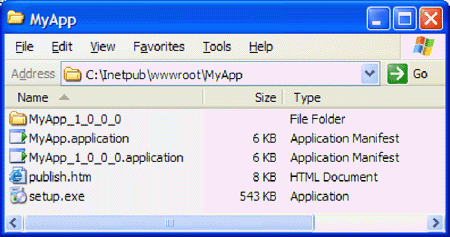When you publish your application, a folder and four files are automatically generated in the publishing directory (see Figure 1-5). They are:
A folder containing the deployment files (MyApp_1_0_0_0; see next section).
An application manifest—MyApp.application. The publish.htm file points to this application.
A version-specific application manifest; for example, MyApp_1_0_0_0.application.
A publish.htm web page containing instructions on how to install the application (this page was covered earlier).
A setup application (setup.exe).
The application manifest MyApp.application is an XML file that contains detailed information about the current application as well as its version number. It lets users know if they need to update application.
When you re-publish your application, the contents of MyApp.application, publish.htm, and setup.exe will be modified, while one new version-specific application manifest (for example, MyApp_1_0_0_1.application) and a new folder (for example, MyApp_1_0_0_1) containing the new versions of deployment files will be created.
Get Use ClickOnce to Deploy Windows Applications now with the O’Reilly learning platform.
O’Reilly members experience books, live events, courses curated by job role, and more from O’Reilly and nearly 200 top publishers.


